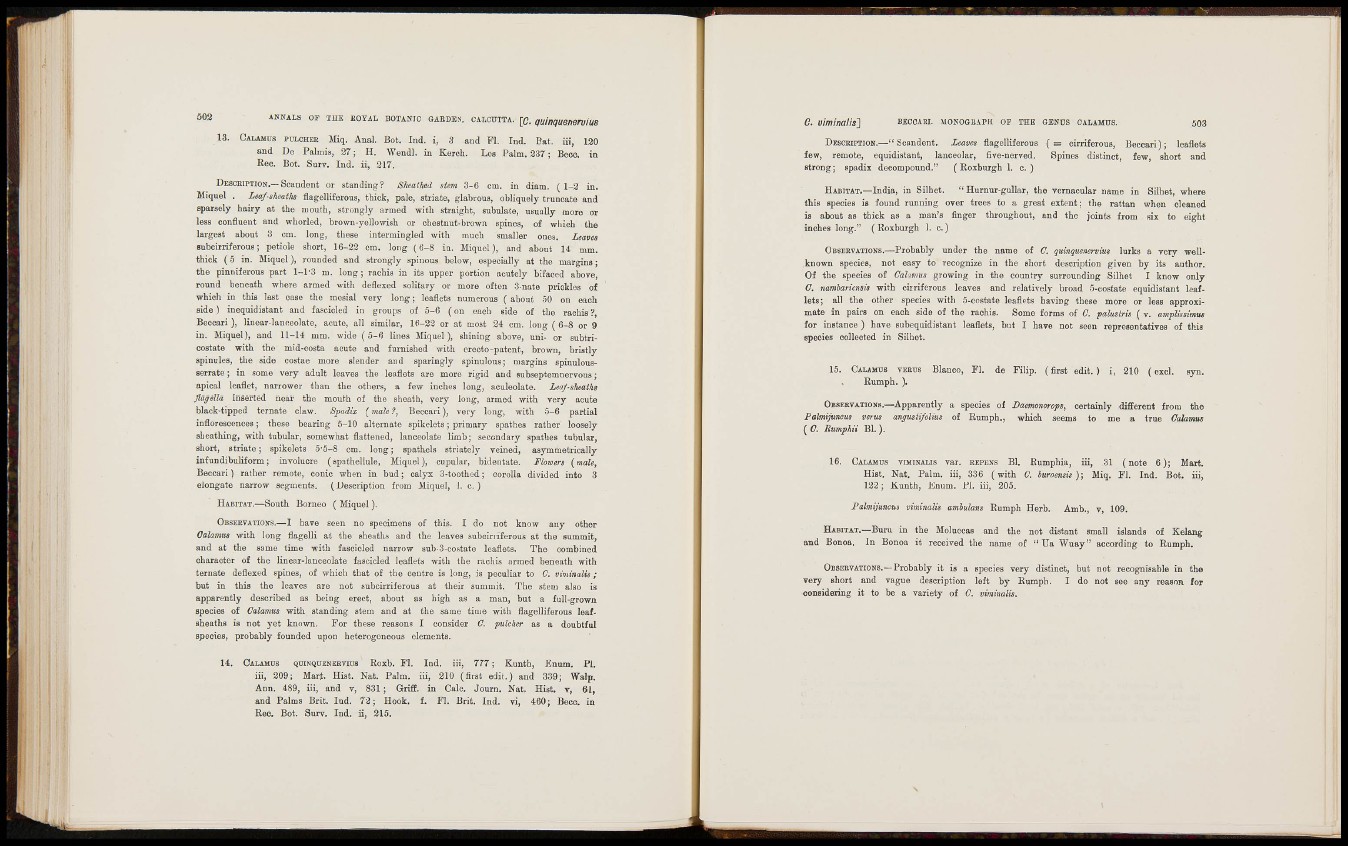
I ANNALS OF THE KOTAL BOTANJC GARDEN, CALCUTTA. QUINQUENERVLUS
13. CALAMUS PULCHER Miq. Anal. Bot. I n d . i, 3 and PI. Ind. Bat. iii, 120
and De Palmis, 27; H. Wendl. in Kerch. Les Palm. 237; Becc. ia
Rec. Bot. Sury. Ind. 217.
DESCRIPTION.-Seandent or standing? Sheathed stem 3-6 cm. in diam. (1-2 in.
Miquel . Leqf-sheaifis flagelliferous, thick, pale, striate, glabrous, obliquely truncate and
hairy at the nioufh, strongly armed with straight, subulate, uKuolly more or
confluent and whorled, brown-yellowish or chestnut-browu spines, of which the
about 3 cm. long, these intermingled with much smaller ones. Leaves
BubcirriferouB; petiole short, 16-22 cm. long (6-8 ia. Miquel), and about 14 mm.
thick (5 in. Miquel), rounded and strongly spinous below, especially at the margins;
the pinniferous part 1-1'3 m. long; rachis in its upper portion acutely bifaced above,
round beneath where armed with deflesed solitary or more often 3-nato piiokles of
which in this last case the mesial very long; leaflets numerous ( about 50 on each
side ) inequidistant and fascicled in groups of 5-6 (on each side of the rachis ?,
Beccari ), linear-lanceolate, acute, all similar, 16-22 or at most 24 cm. long ( 6-8 or 9
in. Miquel), and 11-14 mm. wide ( 5 - 6 lines Miquel), shining above, uui- or subtricostate
with the mid-costa acute and furnished with erecto-patent, brown, bristly
spinules, the side costae more slender and sparingly spinulous; margins spinulousserrate
; in some very adult leaves the leaflets are more rigid aud subseptemnervous;
apical leaflet, narrower than the others, a few inches long, aculeolate. LeaJ-sheaihs
Jlagella inserted near the mouth of the sheath, very long, armed with very acute
black-tipped ternate claw. Spadix {male?, Beccari), very long, with 5-6 partial
inflorescences; these bearing 5-10 alternate spikelets; primary spathes rather loosely
sheathing, with tubular, somewhat flattened, lanceolate limb; secondary spathes tubular,
short, striate; spikelets 5-5-8 cm. long; spatliels striately veined, asymmetrically
infundibuliform; involucre (spathellule, Miquel), cupular, bidentate. Flowers {male,
Beccari) rather remote, conic when in bud; calyx 3-toothed; corolla divided into 3
elongate narrow segments. (Description from Miquel, 1. c. )
HABITAT.—South. Borneo ( Miquel ).
OBSERVATIONS.—I have seen no specimens of this. I do not know auy other
Qalamui with long flagelli at the sheath.s and the leaves subciriiferous at the summit,
and at the same time with fascicled narrow sub-3-coKtato leaflets. The combined
character of the linear-lanceolate fascicled leaflets with the rachis armed beneath with
ternate deflexed spines, of which that of the centre is long, is peculiar to C. viminalis ;
but in this the leaves are not subcirriferous at their summit. The stem also is
apparently described as being erect, about as high as a man, but a full-grown
of Calamus with standing stem and at the same time with flagelliferous leafis
not yet known. For these reasons I consider C. pulcher as a doubtful
species, probably founded upon heterogeneous elements.
14. CALAMUS QUINQUENERVIUS Roxb. Fl. Ind. iii, 777; Kunth, E:
iii, 209; Mari. Hist. Nat. Palm, iii, 210 (fii'st edit.) and
Ann. 489, iii, and v, 831 ; Grifl.
and Palms Brit. Ind. 72; Hook. f.
Ree. Bot. Surv. Ind. ü, 215.
I. PI.
Walp.
. Cale. Journ. Nat. Hist, v, 61,
Fl. Brit. Ind. vi, 460; Becc. in
C. viminalis'} BßCCAEI . MONOGEAPH O F T H E GENUS CALAMUS. 503
DESCRIPTION,—" Scandent, Leaves flagelliferous ( = cirriferous, Beccari); leaflets
few, remote, equidistant, lanceolar, five-nerved. Spines distinct, few, short and
strong; spadix decompound." ( Roxburgh 1. c. )
HABITAT.—India, in Silhet. " Hurnur-gullar, the vernacular name in Silhet, where
this species is found running over trees to a great extent; the rattan when cleaned
is about as thick as a man's finger throughout, and the joints from six to eight
inches long." (Roxburgh 1. c,)
OBSERVATIONS.—Probably under the name of C. quinquenervius lurks a very wellknown
species, not easy to recognize in the short description given by its author.
Of the species of Calamus growing in the country surrounding Silhet I know only
C. nambaricnm with ciiriferous leaves and relatively broad 5-costate equidistant leaflets;
all the other species with 5-costate leaflets having these more or less approximate
in pairs on each side of the rachis. Some forms of C. palustris ( v. ampUssimus
for instance ) have subequidistant leaflets, but I have not seen representatives of this
species collected in Silhet.
16. CALAMUS VEEUB Blanco, Tl. de Filip. (first edit. )
Rum ph. ).
210 (excl. syn.
OBSERVATIONS.—Apparently a species of Daemonorops, certainly different from the
Palmijuneus vertís arigusUfolitis of Rumph., which seems to me a true Calamus
( C. Rumphii Bl. ).
16. CALAMUS VIMINALIS var. REPENS Bl. Rumphia, iii, 31 (note 6); Mart.
Hist. Nat. Palm, iii, 336 (with C. buroensis )•, Miq. Fl. Ind. Bot. iii,
122; Kunth, Enum. PI. iii, 205.
Palmijuneus viminalis ambulans Rumph Herb. Amb., v, 109.
HABITAT.—Burn in the Moluccas and the not distant small islands of Kelang
and Bonoa, In Bonoa it received the name of " Ua Wuay" according to Rumph.
OBSERVATIONS.—Probably it is a species very distinct, but not recognisable in the
Tery short and vague description left by Rumph. I do not see any reason fop
considering it to be a variety of C. viminalis.